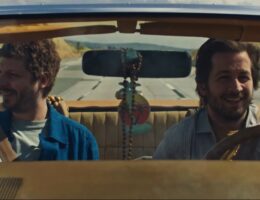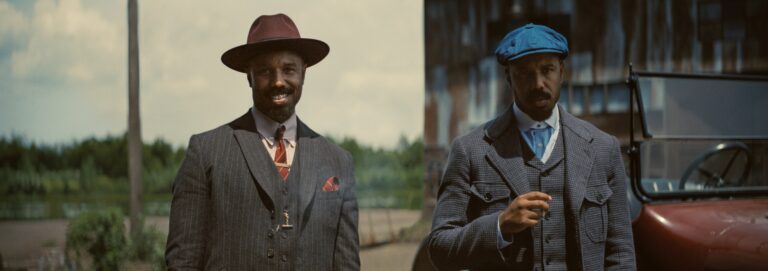Sinners (2025 | USA | 131 minutes | Ryan Coogler)
Following his indie debut, Ryan Coogler was launched into a string of astronomically successful films built on longstanding intellectual property: Marvel’s Black Panther and the Rocky franchise’s Adonis Creed. That the up-and-coming Oakland-based director was able to play in these existing worlds and make films that were both commercially viable and artistically satisfying is a rare feat. With Sinners, it feels like he’s working with a blank check to tell a wholly original story. Here, he again teams-up with his perpetual leading man to answer a question the world’s long been pondering: are two Michael B. Jordans better than one? And also … maybe there are vampires?
What’s in store and at stake is not subtle, but it takes a while to get there. Coogler opens with an animated prologue about the mystical ability of the greatest musicians to pierce the veil between the living and the dead, a transformational power that brings both great healing and one that also courts the darkest evils. The screen then — if you’ve chosen your theatrical exhibition experience correctly — expands vertically and we meet Sammie “Preacher Boy” Moore arriving at what turns out to be his father’s small church. He staggers into the small chapel’s white walls mid-sermon, bloodied and scarred, clinging to the neck of a guitar and seeking salvation. The screen cuts to black and a title card lets us know we’re rewinding to what’ll be a very eventful one day prior.
Set in the Mississippi delta in 1932, Sinners finds a pair of twin brothers Smoke and Stack returning to the hometown the left nearly a decade ago. Played by Michael B. Jordan and Michael B. Jordan, we first meet them passing a rolled cigarette back and forth to acclimate us to the camera trickery yet to come. (It eventually stops being weird, particularly when the plot separates them for a long stretch.) They’ve seen the trenches of World War One and have flourished in Chicago among the ranks of Al Capone’s Mafia. Now, with a duffel bag full of cash and a truck full of Irish beer and Italian wine, they’re ready to put down some roots, buy an old mill from a pretty sketchy white pillar of society, and turn it into their own juke joint. That they need to open it that night and make money immediately hints at the propriety of their resources, but you have to respect the hustle.
Despite the looming deadline, the first third of the movie plays out at a relaxed pace. We see Sammie’s Saturday opening with an early day meeting his cotton picking quota on the sharecropping farm so that he can get his beloved shiny guitar from behind his dad’s pulpit. He’s soon along for the ride with his twin cousins as they hustle around town to assemble a crew to open their juke joint. We learn that both men left women behind: one a soulful potion-making wife (an exceptional Wunmi Mosaku) and a lost child; the other, a white-passing childhood lover (Hailee Steinfeld, incredibly charismatic) with a proclivity for head-to-mid-thigh pink. They also lure a perpetually drunk musician (hilarious yet stoic Delroy Lindo) away from his reliable weekend gig to open their club and enlist the services of married Asian grocers (Helena Hu and Yao) to stock the kitchen and paint their signage. It’s a town of constant negotiation and bartering, but the twins carry a strong reputation, aren’t afraid of pulling a weapon, and have a way of getting what they want.
As much as there’s an efficiency to introducing this whole world as the twins go about their errands, you can tell that Coogler loves building out this world and each character’s history. Taking his time to reflect the rich textures of the Jim Crow South, he’s is in no hurry to force the plot forward. Working again with cinematographer Autumn Durald Arkapaw (Wakanda Forever) they luxuriate throughout, shooting on high resolution film to capture the vistas of the fields, the open air car zipping through the countryside on dirt roads, as well as the expressive faces of the collection of characters we meet. If you’re seeing it in IMAX (recommended!) be ready for the aspect ratio to alternate between the tall, square, immersive IMAX frame and the super wide 5 perf 70mm Panavision 2.76:1 aspect ratio, with the screen filling the frame at moments of heightened emotions. [The preview screening was held at Regal Thornton Place’s relatively small IMAX; so I’m envious of the effect on Pacific Place’s gargantuan screen.]
It’s only after they’ve assembled the whole crew of specialists, with some lessons about (and some actual) hot and sweaty lovemaking along the way, that the sun starts to set on the town. It’s then, in a dark metal scored cutaway, that Coogler gives us a gruesome peek at what’s to come in the form of an encounter with a terrifying ruby-eyed traveler (Jack O’Connell) who finds shelter from a pair of Choctaw Indians (and the lingering daylight) with a couple (Lola Kirke and Peter Dreimanis). They take the fleeing Irishman’s gold rather than heeding the Native American’s advice, and quickly find themselves on the wrong side of his fangs.
Elsewhere, the juke joint’s debut is off to a tremendous debut. Seemingly the entire town arrives for drinking, fried catfish, gambling, and set after set of the region’s finest Blues musicians. As with the first act, you can feel Coogler’s appreciation for the scene, the connections between different characters, their flirtatious energies, and long histories. Even though you might be there for the thrills of a vampire movie, there’s a degree to which you never want the good times to end, never moreso than a thrillingly audacious climax when Sammie finally busts out his guitar and takes the stage and the whole universe goes wobbly with the power of his voice and his command of his instrument. In a breathtaking sequence — a Blues spin on dream ballet — time and space collapse, musicians and dancers from different eras appear in the crowd as a visual metaphor for music as a connective tissue that evolves, changes, mutates, and unites. At its best, it can feel like the roof’s on fire.
But these flames of passion also have a way of attracting blood-suckers looking for an invite inside. Sure, an Irish musical trio sounds nice in theory, but when they show up to play an unannounced set in your parking lot, you know it’s bad news. As their leader O’Connell is beguilingly terrifying; he and his crew get a companion musical sequence that casts indie folk revivals as the ultimate evil. It’s here that we should pause to praise frequent Coogler-collaborator Ludwig Göransson; his scores are reliably great (Oppenheimer is his most recent Oscar-winning banger), but I had no idea that weaving together these disparate traditional musical genres was in his wheelhouse. Between his original compositions, the brilliantly curated soundtrack, and eerie sound design, the movie’s a sonic masterpiece.
The final act comprises the most traditional vampire confrontation — all our friends are holed up in one place, and hordes of bad guys want in. But there’s a refreshing originality in how they discover what’s going on, the alliances that their fanged foes play on, and even some nuance to the eternal nightwalkers’ sales pitch. Coogler’s script casts them as two ancestral groups who’ve faced forced migrations, discrimination, and extreme poverty only to gain a foothold in their new country’s promise of success. Some might argue that they share an even more nefarious foe, hiding in plain sight an under white hoods. These themes, this setting, and this story as nexus is clearly near and dear to Coogler’s heart. It’s a rich cosmic gumbo and he takes his sweet time weaving them into a rich tapestry and then leaves the audience to make some of the necessary leaps of plot mechanics. For a time, this might make the storytelling can feel a bit messy (or improvisational) and the film’s pacing unexpected and digressive. But as you settle in, one comes to understand that these choices result from reflecting a very messy history, not told frequently enough, and you can’t necessarily expect to run on conventional timetables.
What isn’t ever sloppy is the execution. The realization of this world and its characters set at odds with each other is exceptional, and being immersed in it is never not a great deal of fun. While the buildup may be slow, the push to the end is thrilling and gory. The blood flows, the kills rock, and the deaths really hurt. While I’d argue that the gimmick of one character playing twins is wholly unnecessary, I also can’t argue too hard with Coogler and Jordan cashing in their chips to go for it. Although they’re played by the same actor, both brothers get their own personalities — one a savvy protector, the other impulsive and rough around the edges — and it basically works. “Both” distinguish themselves and get meaningful storylines and outstanding endings. Amid a very starry cast of talented actors, newcomer Miles Caton makes a hell of an impression with both his performance and his incredible voice. We start and end with him, and being invested in his story is a feat of spotlight sharing.
All in all, the whole film is a best case scenario for an auteur getting to do what he wants. You can — and should — watch Coogler’s thoroughly educational explanation of the various film stocks and formats, but the short answer is see it on your town’s biggest IMAX (so long as aspect ratio switches don’t make you irrationally angry). And no matter what, stay for the mid-credits scene. In a refutation Marvel’s habit of making audiences wait around to gobble up what turn out to be minute plot breadcrumbs or throwaway cameos, Sinners puts on a great show and rewards you for staying by serving up one of the film’s most emotionally satisfying moments in its encore.
Sinners arrives in theaters on April 18 in theaters in a variety of formats. Choose wisely (big)
Photo Credit: Courtesy of Warner Bros. Pictures




